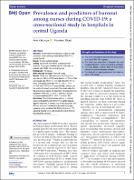Prevalence and predictors of burnout among nurses during COVID-19: a cross-sectional study in hospitals in central Uganda
Abstract
Objective To determine the prevalence of burnout and
associated factors among nurses during COVID-19
in
central Uganda.
Design A cross-sectional
design.
Setting Nurse from one referral and four general
hospitals. These were reception centres and cared for
patients with COVID-19
in central Uganda.
Participants 395 nurses.
Main outcome measures Burnout scores.
Results Of the total 395 participants, 65.1% (n=257)
were female; 40% (n=158) had a diploma; 47.1% (n=186)
were single; and 39.2% (n=155) had worked for 11–15
years. The results show that 40% (n=158), 41.77%
(n=165) and 18.23% (n=77) reported high, average and
low levels of burnout, respectively. The results show that
the predictors of nurses’ burnout were personal protective
equipment (PPE) (OR: 7.1, 95% CI 4.08 to 12.31) and
increased workload (OR 4.3, 95% CI 2.43 to 7.93).
Conclusion This study of nurses working in hospitals
dealing with patients with COVID-19
in central Uganda
reported high rates of burnout, and it was associated with
PPE and workload. Interventions like contracting new
nurses to reduce workload, the WHO guidelines on PPE,
adjusting working hours and ensuring hours of effective
rest should be adapted.
Collections
- Research Articles [54]

